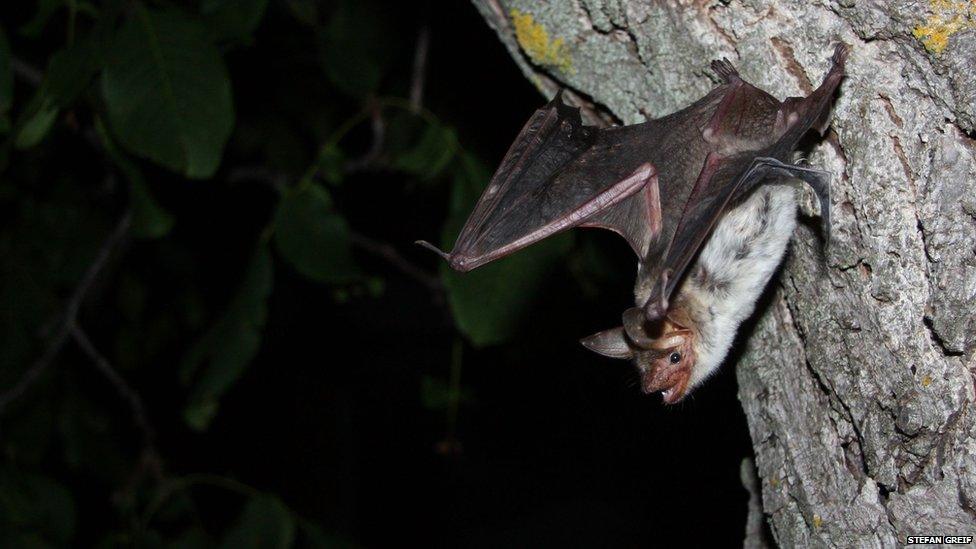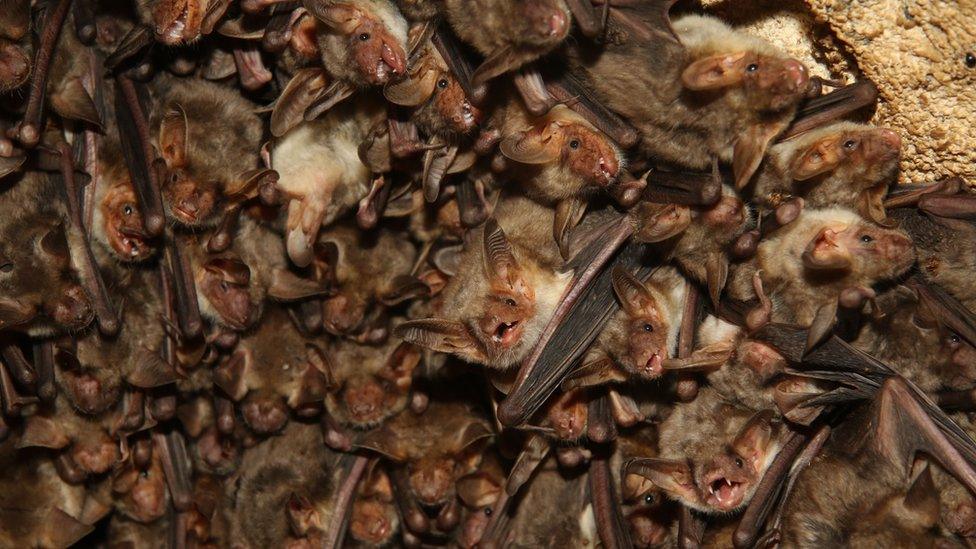Bats 'tricked' into flying into buildings
- Published
- comments

Greater mouse-eared bats (Myotis myotis) were studied in experiments
Modern buildings with large expanses of glass or mirrored surfaces are "potentially dangerous" for bats, research suggests.
Scientists are calling for monitoring of the risks, particularly in areas where bats congregate in large numbers.
Bats have a remarkable ability to fly at high speeds in the dark avoiding natural hazards such as trees.
Yet, smooth, vertical surfaces such as glass windows create a "blind spot" for the flying mammals, a study shows.
"Bats predominately rely on their echolocation system to forage, orientate, and navigate," says a team led by Dr Stefan Greif of the Max Planck Institute for Ornithology near Munich in Germany.
"We found that bats can mistake smooth, vertical surfaces as clear flight paths, repeatedly colliding with them, likely as a result of their acoustic mirror properties."
Collision risk
Bats use echolocation to detect obstacles in flight, find their way into roosts and forage for food.
As they fly, they make calls and listen to the returning echoes to build up a sonic map of their surroundings.
Bats can flit through natural obstacles, such as forests, which return some echo back to them.
However, vertical mirroring surfaces such as window panes appear to trick them into thinking that the way ahead is clear.
Prof Gareth Jones of Bristol University, who is not connected with the study, is an expert on bat echolocation.
"Sound reflects away in front of a bat flying over water, and the flight route ahead is often clear, or interrupted with obvious targets like trees that can be detected by echolocation," he explained.
"Vertical surfaces seem to reflect sound in ways that make the surface difficult to detect, and increase collision risk."

A colony of greater mouse-eared bats
Smooth vertical surfaces are rare in bats' natural habitat. However, they treat horizontal, smooth surfaces like water, and attempt to drink from them.
To investigate the issue, researchers analysed the flight behaviour of greater mouse-eared bats (Myotis myotis) in dark flight tunnels.
The researchers placed a metal plate either vertically or horizontally in the corner of the tunnel and watched what happened.
Of 21 individual bats, 19 collided with the vertical plate at least once but never with the horizontal plate.
When the bats collided with the vertical plate, they were producing fewer calls and approaching the plate at a more acute angle and at higher flight speeds compared with the bats that avoided collision.
Similar findings were found with three species of bat in the wild.
No bats were injured in the experiment.
Nature-friendly cities
The findings, published in the journal, Science, external, may explain why injured or dead bats are sometimes found near buildings.
The researchers are calling for more evidence to be gathered on the scale of the threat to bats.
They say smooth vertical services should be avoided at sites where bats migrate, forage or raise their young.
"Only if we identify and evaluate the real extent of collisions with acoustic mirrors can we avoid or mitigate potential detrimental effects on bat populations," said Dr Greif and co-researchers.
Commenting on the research, Prof Kate Jones of University College London, said: "As we try and encourage more sustainable and nature-friendly cities, it is really important to understand how city design will impact wildlife populations and this study provides some key information for bats."
Bats make up one fifth of all land mammals.
They are among the most endangered of the world's animals, because much of their habitat has been destroyed.
As important pollinators for many plants, and key predators of insects, their loss has serious consequences for the planet.
Follow Helen on Twitter, external.
- Published29 June 2017
